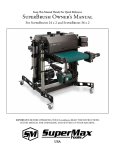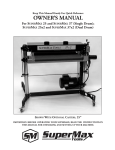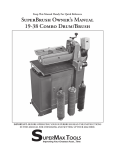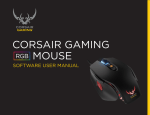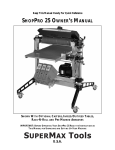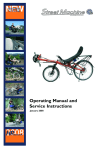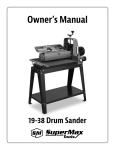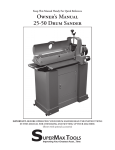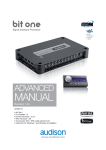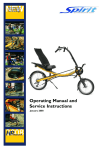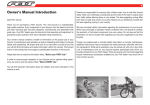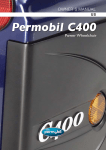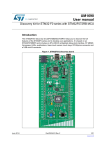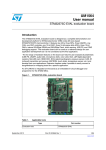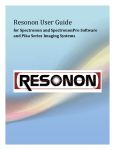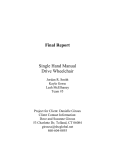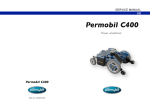Download SUPERBRUSH OWNER`S MANUAL
Transcript
Keep This Manual Handy For Quick Reference SUPERBRUSH OWNER’S MANUAL For SUPERBRUSH 24 and SUPERBRUSH 36 shown with optional accessories IMPORTANT: BEFORE OPERATING YOUR SUPERBRUSH READ THE INSTRUCTIONS IN THIS MANUAL FOR UNPACKING AND SETTING UP YOUR MACHINE. USA 2 SUPERBRUSH OWNER’S MANUAL CONGRATULATIONS CAUTION, SAFETY FIRST You have made a wise purchasing decision by adding this “Made In USA” machine to your tool line-up. The main purpose in inventing and developing the machine you’ve purchased was to bring a new dimension of productivity to your workshop, be it large or small. Right from the start, our goal at SuperMax Tools has been to manufacture equipment that is capable of providing you with maximum economy, maximum utility, and maximum performance. Your SUPERBRUSH will pay you back many fold in the years ahead by helping you get better results in less time, start to finish. This tool incorporates a bundle of exclusive features which you will appreciate more every time you use it. All SuperMax Tools brush sanders feature a variable brush speed (RPM) and the exclusive variable-speed power feed conveyor system. Together, they provide you with ultra-precise control, for a variety of applications. SuperMax Tools and its dealers are committed to providing you with innovative solutions, from selecting the right machine to helping you get top performance when you put it to work in your shop. Regardless of how you take advantage of these innovations, we are confident our equipment will help bring you a giant step forward in precision shop productivity. When maintaining and operating this machine, always put safety first. For your own safety, read and understand this owner’s manual before operating this machine. Always heed and follow all normal safety precautions, including the following: • Always wear eye protection while operating the sander. • Always feed stock against the brush rotation. • Never place hands or fingers under the brush or dust cover. • Keep hands and clothing away from operating brush. • Never operate the sander without its dust cover or pulley guarding in place. • Always maintain control of boards to avoid kickback; know how to prevent it. • Always disconnect electrical power before doing any servicing or adjusting of the machine. MODEL IDENTIFICATION Your SUPERBRUSH sander is one of a family of machines from SuperMax Tools designed to help you achieve results comparable to industrial-size sanders at a fraction of the cost. The SUPERBRUSH is available in 24˝ or 36˝ sizes. For future reference, find the model and serial numbers on the table mount bracket (#42, page 29) and write them in below. Model:_________________________________ Serial Number: __________________________ Date Purchased: _________________________ Dealer: ________________________________ ______________________________________ IMPORTANT : KEEP THIS MANUAL HANDY Please read this manual first. It was designed to help you get the most from your SUPERBRUSH sander. Before unpacking or using the machine, familiarize yourself with its components, features, and basic adjustments by reviewing the following pages. You will find it an invaluable aid in setting up, operating and servicing your machine. If, after reviewing this manual, you still have a problem you can’t solve, please call your SuperMax Tools dealer. MANUAL CONTENTS 3 CONTENTS ABOUT THE SUPERBRUSH SYSTEM SUPERBRUSH Nomenclature ......................4 Unpacking Your SUPERBRUSH Sander .......5 SETTING UP YOUR SUPERBRUSH Making Electrical Connections .................6 Connecting Dust Collectors .....................7 Checking For Machine Level ....................7 Checking Brush Alignment ......................7 Checking Table Height Controls ..............7 Brush Speed Adjustment...........................8 Checking Conveyor Belt...........................8 OPERATING YOUR SUPERBRUSH Basic Operating Procedures ......................9 Adjusting Tension Rollers .........................9 SUPERBRUSH Operating Controls..............9 Setting Depth of Cut ..............................10 Selecting Stock Feed Rates ......................10 Using The Depth Gauge.........................11 Monthly Maintenance ............................11 TIPS FOR MAXIMUM PERFORMANCE .....................................12 TROUBLESHOOTING YOUR SUPERBRUSH Troubleshooting Guide: Motors..............13 Troubleshooting Guide: Conveyor..........14 Troubleshooting Guide: Machine ...........15 SERVICING YOUR SUPERBRUSH Adjusting Height Controls......................16 Adjusting Table Support Castings ...........16 Adjusting Brush Head ............................16 Leveling Table.........................................18 Miter Gear Alignment ............................18 Brush Speed Adjustment.........................19 Replacing Brush ............................20 & 23 Replacing Conveyor Belts .......................20 Replacing V-Belt ....................................21 Rotating/Replacing Bearings...................22 Replacing Electrical Components ...........24 Electrical Diagrams........................25 & 26 SUPERBRUSH TECHNICAL DATA SUPERBRUSH Specifications .....................27 Parts List For Stand.................................28 Parts List For Brush Assembly.................30 Parts List For Conveyor Assembly...........32 SUPERBRUSH Accessories & Supplies .......35 FOR YOUR SAFETY: Read all instructions carefully, and note the safety cautions on the opposite page and on the back cover of this manual. 4 SUPERBRUSH OWNER’S MANUAL ABOUT THE SUPERBRUSH SYSTEM This manual is designed to help familiarize you with your SUPERBRUSH sander, and to help you take advantage of its exclusive features. By understanding its major components, and how they work together, you will be able to get the most from your investment.The SUPERBRUSH system is basically made up of: 1) a height adjustment handle HEIGHT ADJUSTMENT HANDLE which raises and lowers the conveyor table; 2) a brush speed control handle which controls brush speed from 400 to 1200 RPM; 3) a motor starter switch which starts and stops the drive motor and sanding brush; and 4) a feed rate control knob which starts feed conveyor and selects feed rate from 0-15 feet per minute. DUST COVER SANDING BRUSH BRUSH SPEED CONTROL HANDLE (RPM) DEPTH GAUGE MOTOR CONTROL SWITCH TENSION ROLLER FEED CONVEYOR FEED RATE CONTROL KNOB GEAR MOTOR LEFT (OUTBOARD) SIDE MITER GEARS RPM GAUGE MAIN MOTOR RIGHT (INBOARD) SIDE Fig. 1. SUPERBRUSH nomenclature. ABOUT THE SUPERBRUSH SYSTEM 5 UNPACKING YOUR SUPERBRUSH Your SUPERBRUSH sander has been shipped completely assembled from the factory in a shroud on a pallet and shrink-wrapped in plastic. If any damage has occurred as a result of shipment, notify the transportation company as soon as possible and ask them to make an immediate inspection. Ask for a damage or loss report. Also notify your dealer of any loss or damage during shipment. See enclosed Warranty Statement. Important: To avoid problems and potential damage to the machine, please read through the unpacking instructions below before proceeding to set up the machine in your shop. 1. Unbolt the machine legs from the shipping pallet. Install the rubber-based leveling feet or optional caster set on legs (Fig. 2). The feet and mounting hardware are in the STOP bag packed with your machine. 2. Loosen the hex nuts and set screws on the table support castings (Fig. 3) and on the motor support casting (7)(Fig. 5). The set screws on the table support castings have been tightened at the factory to eliminate free-play between the castings and the column tube during shipment. There are two table support castings on the SUPERBRUSH, one each for the right and left column tubes, and one motor support casting, all with set screws. Important: These set screws are tightened for shipping and must be loosened and readjusted before operating either the height adjustment mechanism or the brush speed control handle. To properly adjust for operation, loosen each set screw by first loosening its hex nut with a wrench and then the set screw with an Allen wrench. Then retighten each set screw with your fingers so it only lightly touches the column tube. Hold each set screw in position with an Allen wrench and retighten the hex nut. Failure to follow these procedures may result in misalignment of the brush and/or the conveyor table. Caution: Do not loosen the set screws on the upper brush support castings. Note: Some machines have a block of wood under the main motor. If so, remove at this time. 3. Install the conveyor gear motor. Rotate the drive roller on the conveyor system so the flat part of the shaft is down. If necessary, connect the conveyor motor into an appropriate AC outlet (see page 6, “Making Electrical Connections”), to rotate the motor output shaft coupling so the set screws face downward. Disconnect electrical supply. Slide the conveyor motor assembly onto the drive roller shaft, aligning the shaft coupling and four mounting holes. Start the four 5/16” hex head bolts on the conveyor motor mounting bracket, but do not tighten yet. Next, tighten the set screws in the coupling on the drive roller shaft, making sure they are on the flat of the shaft. Rock the drive roller while tightening the set screws to make sure they are centered properly on the flat. Install the bottom cover on the control box with two screws. Then connect power to machine and turn conveyor on full speed. While it is running, tighten the four 5/16" bolts to secure the conveyor motor assembly in place. TABLE SUPPORT CASTING STAND LEG LEVELING FOOT HEX NUT & SET SCREW Fig. 2. Leveling foot and mounting hardware. Fig. 3. Table support casting and set screws. 6 SUPERBRUSH OWNER’S MANUAL SETTING UP YOUR SUPERBRUSH Your SUPERBRUSH sander was adjusted and aligned at the factory, and it has been carefully packed for shipment. However, because of possible stress during transit, the unit should be thoroughly checked before being put to use. This section covers the pre-operational checks you should make after unpacking and final assembly. Unnecessary problems can be avoided if these essential checks are performed before operating. Likewise, performing the recommended monthly maintenance procedures (page 11) will help assure trouble-free service. MAKING ELECTRICAL CONNECTIONS Power for the brush of your SUPERBRUSH is supplied by either a 5HP, single-phase, a 5HP, three phase, 208-230V motor; or a 5HP, three phase, 460V motor. - Single phase motor: Protected by a thermal overload switch. On single phase machines, a NEMA 14-30 plug is provided. A 30 amp breaker is required. - Three phase motor: No plug is provided. It can be hard wired to a main power source or a plug can be installed to be used with a receptacle. - Three phase, 208V motors require a 20 amp breaker. Fig. 4. Thermal-overload switch on single phase motor (bottom) and conveyor belt motor fuse (top). - Three Phase, 460V motors require a 15 amp breaker and 5 wire connections. 1 2 3 4 10 3 4 5 5 2 2 6 9 8 6 7 Fig. 5. SUPERBRUSH Components. 1. Brush Speed Handle. 2. Adjusting Screw Support. 3. Brush Support Casting. 4. Height Adjusting Screw. 5. Table Support Casting. 6. Miter Gear. 7. Motor Support Casting. 8. Transfer Rod. 9. Shaft Collars. 10. Height Adjustment Handle. SETTING UP YOUR SUPERBRUSH 7 CONNECTING DUST COLLECTORS Dust collection is necessary for all SUPERBRUSH models. The SUPERBRUSH 24 is equipped with one 4˝ diameter dust exhaust port at the top of the brush cover. The SUPERBRUSH 36 has two 4˝ dust exhaust ports. To attach the SUPERBRUSH to your collection system, install 4˝ hose from your collector. (See Tips For Maximum Performance, page 12 of this manual.) The minimum recommended dust collector capacities at the dust port(s) are: SUPERBRUSH 24: 600 CFM; SUPERBRUSH 36: 1,200 CFM. For best results, follow the recommendations of the manufacturer of your dust collection equipment. NOTE: Some applications will require more dust collection than the recommended minimum CFM. CHECKING MACHINE FOR LEVEL Proper leveling of the machine is essential to achieve continued maximum performance from the SUPERBRUSH. Before making fine adjustments, place the unit where it will be used in the shop. Then adjust the four leveling feet using a carpenter’s level both across the machine and in line with the machine, placing the level on the conveyor bed. If you have equipped your SUPERBRUSH with the optional caster set, do the same after positioning the machine where it will be operated most often. Mark the position of the legs on the floor with tape so it can be returned to the same position. Fig. 6. Checking brush alignment and table height adjustment (outboard side). BRUSH ALIGNMENT The brush must be parallel to the conveyor bed surface. Brush alignment can be visually checked by raising the tension rollers (Fig. 6) to their highest position (See Tension Roller Adjustment page 9) and raising the table so that the brush just contacts the conveyor surface. Brush contact should be HEIGHT ADJUSTMENT The table height is controlled by the height adjustment handle (10)(Fig.5). Turning the handle raises or lowers both sides of the table simultaneously by transferring the handle rotation through the miter gear and transfer rod assembly. One revolution of the handle raises or lowers the table 3/32 of an inch. Before operating height adjustment, be sure both set screws located in both table support castings (Fig. 3) are loose to allow table support to slide on both column tubes. (These set screws are tightened for shipping.) Fig. 7. Adjusting brush alignment. 8 SUPERBRUSH OWNER’S MANUAL equal across the width of the conveyor. If the SUPERBRUSH is properly leveled (See checking machine for level), brush misalignment can be corrected by loosening the two set screws at the front of the outboard brush support casting (Fig. 5) and by raising or lowering casting to correct alignment. NOTE: Improper brush alignment will cause uneven results and lead to reduced brush life. BRUSH SPEED ADJUSTMENT The SUPERBRUSH is equipped with a variable speed drive which allows the brush to be operated anywhere between 400 and 1200 RPM. The faster the brush speed, the more aggressive the brush action. The brush speed control handle (1)(Fig. 5) raises or lowers the motor support casting (7)(Fig. 5) which activates the variable speed drive pulley. RPM GAUGE The RPM gauge (Fig. 8) displays the brush speed and is read where the scale intersects the top of the screw support casting. To calibrate the gauge, lower the motor to the lowest position. Loosen both hex nuts while holding set screws. Position the RPM scale so that “400” RPM intersects the top of the screw support casting (Fig. 8). Tighten hex nuts to hold gauge in this position. CHECKING THE CONVEYOR BELT Conveyor belt tracking adjustments may occasionally be necessary during break-in and normal operation to compensate for belt stretching. If adjustments are necessary, follow the instructions below: Belt tracking adjustments are made while the conveyor belt is running. With the conveyor unit on and set at the fastest speed setting, watch for a tendency of the conveyor belt to drift to one side of the conveyor. To adjust the belt tracking, tighten the take-up screw nut (see Fig. 9) on the side the belt is drifting toward, and loosen the take-up screw nut on the opposite side. Adjusting the take-up screw nuts on either side of the conveyor allows belt tracking adjustments to be made without affecting belt tension. Adjust the take-up screw nuts only 1/4 turn at a time. Then allow time for the belt to react to the adjustments before proceeding further. Try to avoid over-adjustments. NOTE: Make sure wrench is below surface when brushing. TAKE UP SCREW NUT Fig. 8. Brush RPM gauge. Fig. 9. Adjusting conveyor belt tracking. OPERATING YOUR SUPERBRUSH 9 OPERATING YOUR SUPERBRUSH Before using your SUPERBRUSH, review the previous pages in this manual on initial set-up and adjustment. In this section, you will learn how to operate the machine. Note that connecting the machine to an adequate dust collection system is necessary before operating the unit. The SUPERBRUSH offers considerable control and versatility through infinitely variable brush speed and feed rate. Experiment with both to find the proper sander performance for a given application. Varying the brush speed makes the brush more or less aggressive. Too aggressive on the brush may tend to raise the grain or round edges. Sometimes it may be better to make two or more passes with a less aggressive brush or setting. The brush is rotating against the direction of feed; therefore, the leading edges of contours will receive more sanding than trailing edges. Stock should be reversed on subsequent passes to sand all surfaces. Stock may also be fed at an angle to allow more brush penetration on the sides. BASIC OPERATING PROCEDURES After you have connected the machine to a dust collection system, you are ready to begin to use the HEIGHT ADJUSTMENT BRUSH SPEED CONTROL CONVEYOR CONTROL SHAFT COLLAR Fig. 10. Operating controls. SUPERBRUSH. The basic operating procedure for the SUPERBRUSH models is as follows (Fig. 10): 1. Set depth of cut/bristle contact (page 10). 2. Set tension rollers to type of stock being sanded (See Tension Roller Adjustment below and Fig. 11) 3. Start sanding brush and select slow brush speed (page 8). 4. Start conveyor and select feed rate (page 10) 5. Start dust collector system. 6. Feed stock through unit. 7. Gradually increase brush speed until the desired finish is achieved (Fig. 8). To feed stock through the SUPERBRUSH, rest and hold the stock to be sanded on the conveyor table, allowing the conveyor belt to carry the stock into the brush. Once the stock is halfway through, reposition yourself to the outfeed side of the machine to receive and control the stock as it exits the unit. TENSION ROLLER ADJUSTMENT Spring loaded infeed and outfeed Tension Rollers (Fig. 11) are provided to maintain downward pressure on stock being sanded and to prevent slippage of the stock on the feed conveyor. When properly set, the Tension Rollers should engage or raise up about 1/8˝ to accommodate the stock being brushed. The Tension Rollers can and must be adjusted to accommodate flat surfaced stock vs highly contoured surface stock. If the Depth Gauge is properly calibrated (page 11), Tension Roller height is adjusted as follows: Note: Make sure brush head is appropriate for application and contact. Flat Surfaced Stock: Set the bottom of the tension rollers even with the bottom of the brush. Loosen the four Tension Roller locking knobs (Fig. 11). Raise the table to the “0” mark on the Depth Gauge. At this position, the brush and Tension Rollers are resting on the table surface. Lock all four Tension Roller knobs. For example, to brush a 3/4˝ thick flat board, lower the table to 5/8˝ on the Depth Gauge. This allows 1/8˝ for Tension Roller engagement and 1/8˝ brush penetration. 10 SUPERBRUSH OWNER’S MANUAL Contoured Surface Stock: (Example: A 3/4˝ thick piece of molding with 3/8˝ of molding relief.) Loosen all four tension roller locking bolts (Fig. 11). Adjust the conveyor table 1/4˝ into the bristle tips (measure with a ruler from “0” mark on depth gauge.). At this position, the tension rollers are resting on the table surface and are positioned 1/4˝ above the bottom of the brush. Lock all four Tension Roller locking bolts. To brush the piece, lower the table to the 3/8˝ position on the Depth Gauge. This allows for 1/8˝ of tension roller engagement and 3/8˝ of brush penetration. DEPTH GAUGE LOCKING KNOBS TENSION ROLLER LOCKING BOLTS SELECTING STOCK FEED RATES Selecting the proper feed rate is essential to proper brushing. Feed rate controls the duration of brushing on a particular spot. A slower feed rate allows more brushing to occur. In some instances, a slow feed rate and slow brush speed may produce the same result as a fast feed rate and fast brush speed. The variable feed rate control of the conveyor belt adjusts the load on the machine; it can be infinitely adjusted for maximum operating performance. A faster feed rate allows faster brushing but fewer revolutions of the brush per inch of sanding. A slower feed rate provides more revolutions of the brush per inch of sanding (Fig. 10). The best feed rate will depend on a number of factors, including type of stock, brush, depth of cut used, and whether the stock is fed directly in line with the conveyor bed or at an angle. When using a wire brush for “distressing” wood, a brush speed of 400-600 RPM with light contact of bristles and a moderate feed rate generally leaves the best finish. Fig. 11. Tension roller and depth gauge adjustment. SETTING BRUSH DEPTH OF CUT/CONTACT SuperMax Tools tests sample applications for all customers before selling a SUPERBRUSH. We recommend following the suggest RPM, contact and conveyor settings outlined in the sample letter. If you have questions about your application(s) or your needs change, please contact SuperMax Tools for updated information or new sample testing, as brush types, materials, etc. may have changed. The information and suggestions listed below are not specific to any application and may have changed since printing. Please call SuperMax Tools if you have questions. When a nylon or wire brush is worn and needs changing, the bristles will either have fractured and the brush head looks “bald” or the bristle length has worn and the bristles are too short for effective brushing. When an abrasive or cloth brush is worn, the brushing material will become smooth or the brush will be considerably smaller in diameter as compared to new. Cloth brush heads may only need cleaning to rejuvenate the cloth. Please call SuperMax Tools if you have any questions. Brush life can vary considerably, due to RPM, contact, type of brush, and material being brushed. OPERATING YOUR SUPERBRUSH 11 Many types of brush heads may be rewound with new bristles or re-equipped with new brush material. Please contact SuperMax Tools if you have questions about a new or re-wrapped brush head. Some types of brush heads, some fladder brushes, for example, will allow changing of the brush material by the operator, thus eliminating the need to send the brush head out for re-wrapping. Please call SuperMax Tools if you have any questions about re-wrapping a brush. When using a wire brush for “distressing” wood, slowing brush RPM, using light contact and a moderate feed rate generally will give the best finish and longest brush life. When using a wire brush on metal, it is important to use a light contact of the bristle tips. Wire brushes frequently flipped end for end, to keep the wire from bending in one direction, will extend brush life. Caution, if you choose not to flip the brush frequently, it is better not to flip the brush at all. Nylon Brushes. “Dress” tips of bristle brush periodically to maintain uniform brush wear and to expose new grit on the ends of the fiber. Dressing Instructions: Staple a wide sheet of 60 grit sandpaper to a 1/2˝ thick flat wood surface. Strips of narrow sandpaper can also be used. Raise the brush so the tips of the bristles contact the sandpaper by 1/32˝. Set the conveyor speed to approximately 50% feed rate. Pass the abrasive loaded board through the machine until the brush fibers are sharp and even. DEPTH GAUGE OPERATION The depth gauge (see Fig. 11) measures the distance between the conveyor table and the bottom of the sanding brush. The sanding brush must be parallel to the conveyor bed surface. To calibrate the depth gauge, loosen the locking knob of the lower depth gauge casting so it rests on top of the table support casting. Raise the conveyor table until it touches the sanding brush. Then loosen the locking knob of the upper depth gauge casting and position the “0” mark of the scale even with the top of the lower depth gauge casting. Lock the upper depth gauge casting in position. Once calibrated, the locking knob of the lower depth gauge casting can be loosened, allowing the lower depth gauge casting to ride on top of the table support casting. The depth can then be read where the scale enters the lower depth gauge casting. The depth gauge can also be used as a stop gauge as follows: Position the lower depth gauge casting along the scale to a desired finish thickness. Then lock the lower depth gauge casting with the locking knob to prevent the conveyor table from being raised above that point MONTHLY MAINTENANCE For best results, perform the following recommended maintenance procedures on a monthly basis: • Lubricate conveyor bushings and check for wear. • Lubricate all moving parts, such as threaded rods, washers, and column tubes. • Clean dust from the conveyor belt. • Blow dust from the motors. • Check all set screws for tightness on parts such as brush support castings, bearings, conveyor coupler, castings, pulleys, and miter gears. • Clean brush, if applicable. 12 SUPERBRUSH OWNER’S MANUAL TIPS FOR MAXIMUM PERFORMANCE The versatility designed into the SUPERBRUSH allows it to be used for a wide-ranging variety of tasks that will boost the return on your investment. Learning to use its multiple adjustments and controls will allow you to fine-tune the machine for maximum results, regardless of the job to be done. The best results come from experimenting with different machine adjustments to fit the job at hand. Following is a listing of useful tips which can help you improve performance of your brush sander. Dust Collection. When connecting dust collectors, remember that straight pipe will not restrict airflow as much as flexible tubing. Also, Ys and elbows will restrict airflow less than Ts. When connecting to the dual ports of the SUPERBRUSH 36, use a larger diameter pipe to the machine, and then split to two 4˝ hoses connected to the ports. An alternative is to use two separate 4˝ lines running to the ports; do not use only one 4˝ line and split it by the machine. Brushing Multiple Pieces At Once. When brushing multiple pieces simultaneously, make sure to stagger (step) the pieces across the width of the conveyor belt. This provides better contact with the tension rollers. Try to only process multiple pieces of similar thickness. If there is a significant thickness difference, the thinner pieces can slip on the conveyor belt if they do not contact the tension rollers. When brushing high stock, special care is needed to prevent tipping. Brushing Imperfect Stock. To avoid personal injury, take special care when brushing stock that is twisted, bowed, or otherwise varies in thickness from end to end. If possible, support such stock as it is being brushed to keep it from slipping or tipping. Use extra roller stands, help from another person, or hand pressure on the stock, to minimize potentially hazardous situations. Stock Feeding Angle. Some pieces, because of their dimensions, will need to be fed into the machine at a 90° angle (perpendicular to the brush). However, even a slight offset angle of the stock can provide for more effective brushing on some stock (Fig. 12). Keeping the Machine Clean. For best results, make cleaning the machine a regular shop procedure. Allowing excess build-up of dust and debris can adversely affect performance, slippage on the conveyor belt, and/or the accumulation of material on the brush which can throw off the center of balance. Leave the dust collector on when cleaning dust from the brush. Also brush the conveyor belt after cleaning operations. If not cleaned, the conveyor belt could allow stock to slip during brushing operations. Fig. 12. Offset stock feeding angle. TROUBLESHOOTING YOUR SUPERBRUSH 13 TROUBLESHOOTING YOUR SUPERBRUSH Any operating problems with the SUPERBRUSH will likely occur most often during the period that you are becoming familiar with its components and their adjustments. If you are experiencing a problem affecting the machine’s brushing performance, check the following listings for potential causes and solutions; it may also pay to review the previous sections in this manual on setting up and operating your machine. TROUBLESHOOTING GUIDE: MOTORS Problem Possible Cause Solution Motors do not start. 1. Main power cord unplugged from receptacle. Plug in primary power cord. 2. Brush motor cord unplugged from receptacle near power-feed motor. Plug in brush motor cord at receptacle on machine if so equipped (Fig. 4). 3. Circuit fuse blown or circuit breaker tripped. Replace fuse or retrip breaker (after determining cause). 4. Brush motor thermal overload protector tripped (Single phase motor only). Reset after allowing to cool; check circuit and/or reduce load or slow feed rate (Fig. 4) 5. Conveyor motor fuse blown. Replace 3/4 amp fuse (page 24). 1. Inadequate circuit. Check electrical requirements (page 6). 2. Machine overloaded. Use slower feed rate; slower brush RPM; reduce depth of cut. 1. Motor not properly aligned. Loosen housing bolts, run motor, retighten bolts. 2. Shaft collar or bushing worn. Replace shaft collar or bushing (page 5). 3. Drive roller bent. Replace drive roller (page 20). 1. Excessive depth of cut. Reduce depth of cut; decrease brush speed; reduce feed rate. Brush motor overloads. Conveyor motor oscillates. Brush motor or conveyor gear motor stalls. 14 SUPERBRUSH OWNER’S MANUAL Problem TROUBLESHOOTING GUIDE: CONVEYOR Possible Cause Solution Conveyor rollers run intermittently. 1. Shaft coupling loose. Align shaft flats of gear motor and drive roller; (page 5) tighten shaft coupling set screws. Conveyor belt slips on drive roller. 1. Improper conveyor belt tension. Adjust belt tension (page 8). 2. Excessive depth of cut. Reduce depth of cut; reduce feed rate. 1. Excessive depth of cut. Reduce depth of cut. 2. Tension rollers too high. Lower tension rollers (page 9). 3. Excessive feed rate. Reduce feed rate. 4. Dirty or worn conveyor belt. Clean or replace conveyor belt. 1. Belt out of adjustment. Readjust belt; (page 8). 2. Drive or driven conveyor belt rollers misaligned. Readjust (page 20). 3. Conveyor table not flat and square. Readjust by leveling machine (page 7). 4. Conveyor belt worn. Replace conveyor belt (page 20). 5. Drive roller worn or damaged. Replace drive roller. (page 20). 6. Roller bushings elongated due to excessive wear. Replace bushings. (page 20). Stock slips on conveyor belt. Conveyor belt tracks to one side, or oscillates from side to side. TROUBLESHOOTING YOUR SUPERBRUSH 15 Problem TROUBLESHOOTING GUIDE: MACHINE Possible Cause Solution Brush height adjustment works improperly. 1. Improper adjustment of height control. Readjust height control (pages 7 and 16). Knocking sound while running. 1. Bearing out of alignment. Rotate bearing (page 22) 2. V-belt worn. Replace V-belt (page 21). 3. Pulleys wobbling or out of round. Tighten set screws or replace pulley (page 22). 4. Set screws loose in pulley or bearing. Retighten set screws. 5. Bearing worn. Replace bearing (page 22). 1. Inadequate support of stock. Use roller stands to support stock. 2. Conveyor drive or driven rollers higher than conveyor bed. Readjust rollers (page 20). 1. Feed rate too slow. Increase feed rate. 2. Excessive depth of cut Reduce depth of cut, decrease brush RPM. 1. Conveyor belt is too loose. Adjust belt tension. 2. Excessive depth of cut. Reduce depth of cut, decrease brush RPM. 3. Wood slipping on conveyor due to lack of contact. Use alternate feeding procedure (page 12). Sniping of wood (gouging near end of board). Burning of wood. or melting of finish Gouging of wood. 16 SUPERBRUSH OWNER’S MANUAL SERVICING YOUR SUPERBRUSH The basic adjustment procedures for your machine are covered under Setting Up Your SUPERBRUSH, page 6. Review that section first. If following the general instructions does not solve a specific problem or result in smooth operation, also check Troubleshooting Your SUPERBRUSH, page 13. Below are suggested procedures to follow when more thorough readjustment or replacement is necessary. ADJUSTING HEIGHT CONTROLS Height adjustment problems may be the result of not loosening the set screws in the table support castings before attempting operation. (This is covered on page 5 of this manual, and also on the separate unpacking sheet which was shipped with your machine.) If the set screws were not loosened as instructed, do so now before proceeding further. Also make sure all moving parts of the height adjusting mechanism are well lubricated, including the miter gears, column tubes, and threaded height adjusting screws. When troubleshooting the height adjustment mechanism, first check the conveyor table for level (see page 7). Then test the height adjustment mechanism (See Fig. 13). If it does not operate Fig. 13. Table support casting set screws. easily, further adjustments may be necessary, as outlined below. Following these steps should result in smooth operation. Readjustment Procedure 1. Loosen the set screws located at the front of the table support castings (Fig. 3). 2. Lubricate thoroughly by applying penetrating lubricant to the table support castings where they contact the column tubes, and to all contact points of adjusting screws and transfer rod (Fig. 15). Also apply grease or oil to the miter gears. 3. If the height adjustment feels stiff, check for misalignment of adjusting screw supports and the brush support castings which could cause binding on the adjusting screw (Fig. 5). These castings can be adjusted by loosening the set screws which secure them to the column tubes. Realign the adjusting screw supports by loosening the two set screws that hold them to the column tubes and rotate to the proper position. 4. The adjusting screw supports located immediately below the height adjustment handle and the left Fig. 14. Adjusting miter gears for proper mesh. SERVICING YOUR SUPERBRUSH 17 TRANSFER ROD Fig. 15. Miter gear below adjusting screw support. Fig. 16. Height controls on outboard side. (outboard) brush support casting (Fig. 15) must both be set at the proper height along the column tubes so the height adjusting screws provide for proper miter gear alignment. Before adjusting these parts, tighten one set screw in the table support castings (Fig. 5) to hold the height adjusting screw in position during adjustment. Also check to see that the column tubes are centered inside the bore of the table support castings (Fig. 5). If not, loosen the casting bolts and tighten the set screws at the front of table support casting to center the tube. Retighten the bolts and loosen the set screws. should be 1/64˝ or less. If there is excessive space, move the adjusting screw support to the proper distance above the miter gear and retighten. Loosen the set screws in the table support castings (Fig. 3) and test for smooth operation. 5. If the height adjustment mechanism feels rough, check the miter gear (Fig. 14) alignment. The miter gears can be adjusted on their shafts by loosening the set screws on the gears. Check and adjust so that the gear mesh is not too tight or too loose, and that the gear teeth align with the opposing gear. Note that the shaft collars located on the transfer rod should be adjusted to control the lateral movement of the transfer rod to maintain accurate miter gear alignment and mesh. The mesh of the miter gears should be smooth and even. If not, adjust the gears for good mesh. Measure the space between the miter gear and the adjusting screw support that holds the height adjusting screw in place (Fig. 15). The distance 6. Next, check the position of the height adjusting screw. First raise the conveyor table. Then check the retaining-clip and washer at the top of the height adjusting screw on the right (inboard) side, and under the height adjustment handle on the left (outboard) side of the machine (Fig. 5). On both sides, the washer and handle should be snug on the casting and retaining the washer. If there is a space between the washer and the casting, tighten one set screw in each of the table support castings. If one height adjusting screw is loose, remove the miter gear from the transfer rod on that side. Turn down the threaded height adjusting screw rod until it is snug on the washer. Make sure both sides are snug on top. Reinstall the miter gear and tighten. Loosen the set screws in the table support castings and test for smooth operation. 18 SUPERBRUSH OWNER’S MANUAL Fig. 17. Adjusting table support castings. Fig. 18. Comparing brush support casting heights. LEVELING TABLE MITER GEAR ALIGNMENT To measure levelness of table, measure the distance between the top of the base casting (Fig. 17) and the bottom of the table support castings. This measurement should be the same for both sides. If it is not the same, adjust as follows: Remove the plastic cap from the miter gear (Fig. 14) on the outboard side of the machine. Loosen the set screw of the miter gear and slide it back to disengage it from the miter gear of the adjusting screw. Turn the adjusting screw handle to raise or lower the outboard side of the table so that the measurement taken above equals the inboard side of the table. After adjusting is complete, re-engage miter gear making sure that miter gear set screw is aligned with flat on cross bar shaft. If height adjustment mechanism does not operate easily, perform the following checks or adjustments: 1. Loosen set screws located on table support castings. (Fig. 3). 2. Lubricate thoroughly! Apply penetrating lubricant to table support castings where it contacts the column tubes, and to all contact points of adjusting screws and cross bar. Apply grease/oil to miter gears. 3. Check miter gear alignment. Check and adjust gears so that gear mesh is not too tight nor too loose and that gear teeth align with opposing gear. The miter gears can be adjusted on their shafts by loosening the set screws on the gears. Note that set screws MUST align with flat of shaft. To raise or lower the vertical miter gears, the adjusting screw support, located immediately above the gears, must also be raised or lowered to ride on top of the gear to maintain adjusting screw position. If vertical miter gear is raised to its highest position, then the adjusting screw (Fig. 5) must be raised, if necessary, to obtain proper gear alignment. Raise adjusting screws as follows: SERVICING YOUR SUPERBRUSH 19 Inboard follow screw (right): Loosen and raise adjusting screw support (Fig. 5).Loosen both set screws located on front of brush support casting and raise inboard side of brush, screw and table to desired height. Retighten set screws of brush support casting (Fig. 3) and re-position and tighten adjusting screw support at top of miter gear. The brush and conveyor table must be re-aligned after this adjustment. See Leveling Table and Brush Alignment (page 7). Outboard Adjusting Screw (left): Loosen and raise adjusting screw support (Fig. 5) above miter gear. Tighten set screw at front of outboard table support casting. Loosen set screw and disengage opposing horizontal miter gear. Turn adjusting screw handle to raise screw to desired height. Re-position adjusting screw support to bottom of handle. Re-position adjusting screw support (Fig. 17) to top of miter gear. Loosen set screws of table support casting (Fig. 3). Re-engage opposing horizontal miter gear. NOTE: Shaft collars (Fig. 10) located on the transfer rod should be adjusted to control lateral movement of the transfer rod to maintain accurate miter alignment and mesh. 4. Check and adjust for misalignment of adjusting screw supports (Fig. 5) and brush support castings which could cause binding on the adjusting screw. These castings can be slightly rotated by loosening the set screws which secure it to the inside of the column tubes. NOTE: The adjusting screw support (Fig. 5) located immediately below the height adjusting handle and the outboard brush support casting, must be set at the proper height along the column tubes to position the adjusting screws so that there is proper miter gear alignment. Before adjusting these parts, tighten one set screw of table support castings to maintain adjusting screw position during adjustment. Fig. 19. Removing brush head. BRUSH SPEED ADJUSTMENT If the brush speed adjustment does not operate easily, perform the following check or adjustments: 1. Loosen set screws located on front of motor support casting (Fig. 3). 2. Lubricate thoroughly!! Apply penetrating lubricant to motor support casting where it contacts the column tubes and to all contact points between adjusting screw and adjusting screw supports (Fig. 5). 3. Improper alignment of adjusting screw supports may cause binding on the adjusting screw. Loosen both set screws on each adjusting screw support to rotate or adjust screw supports. Note that adjusting screw supports control both lateral and vertical movement of the adjusting screw mechanism and must be adjusted accordingly. 20 SUPERBRUSH OWNER’S MANUAL BRUSH MOUNTING BOLTS Fig. 19A. Removing brush head (some models). CHANGING OR REPLACING BRUSH Changing the brush on the SUPERBRUSH is relatively simple. To begin, first disconnect power source to the machine. Lower the motor to its lowest position using the brush speed control handle. Raise the motor to its highest position. This loosens the V-belt tension so the V-belt can be lifted off the driven pulley, pulled back and placed under the control handle to hold it out of the way. Loosen and remove bearing bolts (Fig. 19 and 19A, depending on model. See also page 23 and Fig. 25.) Lift brush out of machine. Loosen set screws of bearing collars and pulley. Remove bearings and pulley and install on replacement brush. Install replacement brush in machine and center brush before tightening bearing bolts. Tighten bearing set screws after bearing bolts are tightened. Install V-belt on driven pulley and adjust pulley for proper V-belt alignment before tightening pulley set screw. REPLACING CONVEYOR BELTS To replace the conveyor belt, the conveyor assembly must be removed from the machine. Lower the conveyor table to its lowest position with the height adjustment handle. Turn off power source to machine. Place conveyor motor assembly on top of dust cover (see #3, page 5). Loosen the conveyor take-up screws (Fig. 21) to relieve belt tension and slide the driven roller fully inward. Remove the four bolts that attach the conveyor assembly to the table mount brackets (see Fig. 21). Lift the conveyor and remove it from the machine by sliding the conveyor out toward the front of the machine. Avoid tearing the belt on any edges underneath the conveyor bed during removal. Reverse the procedure for re-installation. Note: If the conveyor belt continually tracks to one side of the machine, first try reversing the belt on the conveyor bed. If this doesn’t remedy the problem, place a level on the conveyor bed to make sure the conveyor bed is not twisted. If it is twisted, see page 7 for instructions on squaring up the bed. If squaring up the bed does not remedy the problem, proceed with the steps below: Step 1. Check the conveyor drive and driven roller to make sure it is parallel to the surface of the conveyor bed. To do this, first center the conveyor belt on the bed. Then lay a straight-edge on the exposed edge of the conveyor table on the left (outboard) side, extending it over the drive or driven roller. Note the distance between the drive or driven roller and the straight-edge. Step 2. Now repeat Step 1 on the right (inboard) side of the conveyor. Compare the measurements from side to side. If they are not equal, loosen one of the brackets that hold the drive or driven roller in place. Tip this bracket until the distance between the drive roller and the straight-edge are equal from side to side, then tighten the bracket. SERVICING YOUR SUPERBRUSH 21 Conveyor Belt Tension: To adjust the tension of the conveyor belt, first adjust the take-up screw nut (Fig. 21) on both sides of the conveyor to obtain approximately equal tension on both sides of the belt when taut. Insufficient belt tension will cause slippage of conveyor belt on the drive roller during sanding operation. The conveyor belt is too loose if it can be stopped by hand pressure applied directly to the top of the conveyor belt. Excessive belt tension can result in bent rollers, premature wearing of the bronze bushings or conveyor belt Conveyor Belt Tracking: Belt tracking adjustments are made while the conveyor belt is running. After the proper belt tension is obtained (see above), turn the conveyor unit on and set it at the fastest speed setting. Watch for a tendency of the conveyor belt to drift to one side of the conveyor. To adjust the belt tracking, tighten the take-up screw nut (Fig. 21) on the side the belt is drifting toward, and loosen the take-up screw nut on the opposite side. Adjusting the take-up screw nuts on either side of the conveyor allows belt tracking adjustments to be made without affecting belt tension. Note: Adjust the take-up screw nuts only 1/4 turn at a time. Then allow time for the belt to react to the adjustments before proceeding further. Try to avoid over-adjustments. REPLACING V-BELT To change the V-belt on the SUPERBRUSH, first disconnect power source to machine. 1. Lower the main motor to its lowest position using the brush speed control handle. Raise the motor to its highest position. This will loosen the V-belt in the drive pulley so the V-belt can be lifted off the driven pulley. 2. Remove the miter gear from the right (inboard) side of the transfer rod (Fig. 14). (If E clips are attached to the rod, remove both at this time.) Now loosen the shaft collar on the left (outboard) side of the rod, and pull the rod back enough so the V-belt can be removed. (Make sure to catch the nylon washer which will drop off the transfer rod.) 3. Remove the inner half of the pulley guard by removing the six screws holding the inner half to the outer half. Remove the inner half of the pulley guard. 4. Remove the top two bolts holding the top of the outer pulley guard. The outer half of the pulley guard can be removed by pulling it up and out through the head assembly. 5. Remove V-belt from drive pulley. If there is not enough clearance to remove V-belt loosen the four bolts securing the main motor to bracket. Note location of motor before sliding motor out of the way for ease of reassembly. Note the routing of the old V-belt: now remove the old V-belt and replace it with the new V-belt (Fig. 23 and 24). NOTE: If the V-belt will not fit between the drive pulley and the brush support casting, loosen or remove the bolts holding the bearings. Lift brush enough to allow V-belt to be removed. After installing new V-belt, retighten bolts. Machine Reassembly 1. To reassemble the unit after replacing the V-belt, first reassemble the pulley guards. 2. Place the transfer rod back through the machine and reinstall the nylon washer. Tighten the shaft collar (install both of the E clips if so equipped). Reinstall the miter gear on the transfer rod, making sure the set screw is centered on the flat of the rod. 3. Adjust the tension on the V-belt by lowering the motor using the brush speed control handle. 4. Make sure that the V-belt is in alignment. Also check that all belts are tight before using the SUPERBRUSH. 22 SUPERBRUSH OWNER’S MANUAL ROTATING/REPLACING BRUSH BEARINGS Replacing the permanently lubricated bearings on the SUPERBRUSH is a relatively straight-forward procedure. Bearings should be replaced when they allow excessive play of the brush, make excessive noise, or otherwise indicate failure. Note that if clicking noises in the bearings are a problem, rotating may be a solution instead of replacement, as follows: BEARING ROTATING Step 1. Loosen the set screws in the bearing collar. Leave the set screw wrench in one of the set screws. Then rotate the brush within the bearing and tighten the set screws (Fig. 19 and 20). Step 2. If the clicking persists, or if the brush shaft is tight in the bearing and cannot rotate, then loosen the two bolts holding the bearing and the flange for the bearing. Now repeat Step 1. After the brush is rotated within the bearing, tighten the flanges first and then the set screws. After the machine has run for a half hour, stop to check that the set screws and bearing bolts are tight. Bearing Replacement: 1. Disconnect power source to the machine. 2. Lower motor to its lowest position using the RPM adjustment handle. Then raise motor to its highest position using the RPM adjustment handle. This loosens the V-belt tension so the V-belt can be lifted off the driven pulley. 3. Raise conveyor bed until the brush rests on bed. Fig. 20. Conveyor belt replacement. If the left (outboard) bearing is the only one that needs changing, proceed to reassemble the unit. You can check the brush at this point by lowering the conveyor bed and spinning the brush by hand. This will help determine if the inboard bearing needs to be changed to eliminate noise or excessive play in the brush. If replacing both bearings, begin with bearing on the left (outboard) side. Replacing Left (Outboard) Bearing: Make sure power is disconnected to the machine. 1.Remove the outer half of the bearing flange. Loosen the set screws in the bearing collars and remove the bearing. 2. If the shaft of the brush is rough from the set screws, use emery cloth or sandpaper to smooth down any raised edges. Slide the new bearing on the shaft, but do not tighten the set screws yet. 3. Install the outer half of the original bearing flange and tighten the bolts. Then tighten the set screw in the bearing collar. CONVEYOR MOUNTING BOLTS TAKE UP SCREW NUT Fig. 21. Tensioning and tracking conveyor belt. SERVICING YOUR SUPERBRUSH 23 Fig. 23. Removing lower guard and transfer rod. Fig. 24. Removing main motor V-belt drive. Replacing Right (Inboard) Bearing: Disconnect power source to brush. 1. Lower motor to its lowest position using the RPM adjustment handle. Then raise motor to its highest position using the RPM adjustment handle. This loosens the V-belt tension so the V-belt can be lifted off the driven pulley. 2. Raise conveyor table so brush rests on conveyor. 3. Remove left (outboard) bearing by removing the two carriage bolts from bearing. 4. Remove the right (inboard) bearing by removing the two carriage bolts from bearing. 5. Remove V-belt from driven pulley. 6. Lift brush head out from machine. 7. Loosen set screws in bearing collar and driven pulley and remove from brush shaft. 8. Install new bearing and driven pulley. Do not tighten set screws at this time. 9. Install brush in machine and center before tightening bolts. Tighten bearing bolts and then set screws in bearings. 10. Install V-belt on driven pulley and adjust pulley for proper V-belt alignment before tightening pulley set screw. 11. Check the alignment of the brush to the conveyor system. REPLACING BRUSH HEAD 1. Lower motor to its lowest position using the RPM adjustment handle. Then raise motor to its highest position using the RPM adjustment handle. This loosens the V-belt tension so the V-belt can be lifted off the driven pulley. 2. Remove the bearing bolts (Fig. 19, 19A and 25) and lift brush out of machine. Note: Some models have two mounting bolts attaching the bearing housing down into the brush support bracket. These two bolts can be used to remove the brush head instead of the bolts through the bearing flange. 3. Loosen set screws in bearing collars and driven pulley and remove from brush shaft. 4. Install new bearings and driven pulley. Do not tighten set screws at this time. 5. Install brush in machine and center before tightening bearing bolts. Tighten bearing bolts and then set screws in bearings. 6. Install V-belt on driven pulley and adjust pulley for proper V-belt alignment before tightening pulley set screw. 7. Check the alignment of the brush to the conveyor system. (For instructions on this procedure, see page 7 of this manual). 8. Lower the conveyor and spin the brush by hand to make sure the brush shaft is not binding in the bearing. If the bearings bind, loosen the set screws 24 SUPERBRUSH OWNER’S MANUAL BEARING BOLTS Fig. 25. Supporting brushes to remove bearings. Fig. 26. Conveyor motor control box and brush on/off switch. and the bearing flange for one bearing at a time. Spin the brush within the collar, then tighten the bolts in the bearing flange and then the set screws. 9. Test-run the SUPERBRUSH before brushing stock to check that all is operating properly and is aligned before brushing good stock. Also, stop the SUPERBRUSH after a couple hours of use and check the bolts and set screws to make sure they are seated properly. To replace on/off switch, make sure power is disconnected to sander. Remove the two screws holding the front cover of the switch in place. Disconnect and mark wire leads connected to switch mechanism. Remove switch from box and install new switch. Connect wires to new switch following the wiring diagram and marked wires. IMPORTANT: Make sure bare wire does not touch any other wire or the switch box when connected. Install switch assembly and cover. To replace the conveyor gear motor, disconnect the two wire leads from the controller. Also disconnect the plastic grommet protecting the wires passing through the housing. Remove the four cap head set screws that hold the motor to the housing bracket. Remove the old motor and install new motor. Install the wiring leads according to the electrical diagram pertaining to the correct model (See following diagrams). To replace conveyor fuse (Fig. 4), push and turn fuse cap 1/8 turn counter clockwise. Pull cap with fuse from base. Pull fuse from cap and replace with 3/4 amp fuse (pages 25 and 26). Place fuse and cap into base, push and turn 1/8 turn clockwise to secure. REPLACING ELECTRICAL COMPONENTS To replace either the variable-speed controller, or the conveyor motor, use the following disassembly procedure (Fig. 26 and pages 25 and 26): Disconnect the power supply to the machine. Next, remove the bottom plate from the control box. Loosen the set screw in the shaft coupler, and then remove the four 5/16˝ bolts that hold the power feed motor assembly in place. Next, remove the assembly from the machine and turn it upside down to disconnect the leads from the components to be removed. To replace the controller, remove the variable speed control knob. Remove the nut that holds the controller in place and pull the controller out of the housing. Install the new controller, referring to the correct electrical diagram and reverse the disassembly procedure. SUPERBRUSH ELECTRICAL DIAGRAM 25 SUPER BRUSH WIRING DIAGRAM 230 VOLT 1 PHASE, 60 HZ 26 SUPERBRUSH OWNER’S MANUAL SUPER BRUSH WIRING DIAGRAM 230 VOLT 3 PHASE, 60 HZ SUPER BRUSH WIRING DIAGRAM 460 VOLT 3 PHASE, 60 HZ CONTROLLER 3 PHASE 460 V 72-1260 (WHITE) WHITE WHITE NEUTRAL RED SUPERBRUSH SPECIFICATIONS 27 SUPERBRUSH SPECIFICATIONS SUPERBRUSH 24 SUPERBRUSH 36 Warranty: Two years on parts and labor, limited; Manufacturer’s warranties on conveyor belts and brush heads. Dimensions: Dust Hood: Brush Speed: Brush: Bearings: Conveyor Bed: Conveyor Motor: Conveyor Belt: Model 24: Height: 52˝ Width: 46˝; Depth: 42˝ Model 36: Height: 52˝ Width: 58˝; Depth: 42˝ Model 24: Steel hood with 4˝ vacuum port, hinged back Model 36: Steel hood with two 4˝ vacuum ports, hinged back Infinitely Variable, 400-1200 RPM. See Brushes & Supplies, page 35 1˝ sealed, permanently lubricated, ball. Steel reinforced with four steel cross sections. 100 in-lbs. torque, direct-drive DC motor (1/17 HP). Infinitely variable from 0 to 15 feet per minute. Polyurethane, roughtop surface belt, with monofilament back, included. (Optional abrasive belt available.) Stand Construction: Zinc-plated steel, cast aluminum. Column tubes are centerless ground. Drive Motor: Both Models: 5HP, TEFC; 1,725 RPM; 60 HZ. Continuous Duty Single phase 208-230V; Optional three phase: 230V or (460V three phase) Minimum Stock Length: Height Adjustment: Stock Thickness Capacity: Approximate Shipping Weight: All Models 10˝ without fixtures. All Models: 3/32˝ per turn; Depth Gauge with locking stop included. 11˝ maximum, typical* with nylon brushes. 12” maximum, typical* with wire brushes. *can vary depending on specific brush types Model 24: 375 lbs. Model 36: 475 lbs. Tension Rollers: 1 1/2˝ diameter, rubber covered infeed and outfeed rollers mounted under spring tension, fully adjustable. Dust Collection: Mandatory for all models. 28 SUPERBRUSH OWNER’S MANUAL SUPERBRUSH STAND ASSEMBLY PARTS LIST Ref. Number 1 2 3 4 5 6 7 8 9 10 11A 11B 12 13 14 15 16 17 18 19 20 21 22 23 24 25 26 27 28 29 30 31 32 33 34A 34B 35 36 37 38 39 40 41 42 Description SB24 HANDLE, SWIVEL ASSY PIN, ROLL 3/16X1 WASHER, 5/8 I.D. OILITE RING, 5/8 RETAINING SUPPORT, ADJUSTING SCREW SCREW, 1/4-20x1/2 SOCKET HEAD SET SCREW, INBOARD HEIGHT ADJ. FOLLOW CAP, 1” PLASTIC GEAR, MITER BUSHING, 1/2 I.D. OILITE ROUND RPM, BRACKET RPM, DECAL (NOT SHOWN) COLLAR, 1/2 I.D. SHAFT TUBE, COLUMN SCREW, RPM, MOTOR MOUNT, MOTOR NUT, 5/16-18 HEX WASHER, 5/16 SAE SCREW, 5/16-18x3/4 BRASS TIPPED SET BOLT, 3/8-16x1-1/2 HEX HEAD WASHER, 5/16 WROUGHT BOLT, 3/8-16x1 HEX HEAD NUT, 3/8-16 HEX LEVELING FOOT SCREW, OUTBOARD HEIGHT ADJ. NUT, 3/8-16 FLANGE LOCK BASE, COLUMN BASE SUPPORT BRACKET NUT, 5/8-11HEAVY HEX LOCK SCREW, 1/2-13x1/2 SOCKET HEAD SET ROD, TRANSFER SUPPORT BRUSH BOLT, 3/8-16x1 1/4 HEX SUPPORT, OUTBOARD TABLE DEPTH GAUGE ROD DECAL, SCALE NUT, 9/16-12 HEX LEG KNOB, LOCKING W/ SET SCREW CAP, 3Y PLASTIC COLUMN TUBE SCREW, 5/16-18x3/8 SOCKET HEAD SET MOTOR MOUNT SUPPORT, INBOARD TABLE BRACKET, TABLE MOUNT CLIP, FRAME (NOT SHOWN) BUSHING, 1/2 I.D. OILITE ROUND (NOT SHOWN) Part Number Both SB36 Models 31-0020 20-0772 50-3080 20-0752 30-1112 10-2804 30-1211HR 80-4013 20-1101 50-3107 40-0670 94-1674 20-1103 30-3044 30-1209 30-5103 12-0003 11-0206 10-9906 10-9207 11-9103 10-9205 12-0005 20-0655 30-1212HR 12-0209 30-1101 40-0230 40-4241 12-8015 10-8905 30-1213 30-3117 30-5206 10-9206 30-5204 30-1260HR 94-1654 12-0011 30-1102 81-3132 80-4015 10-2903 40-0106 30-5205 40-0025 ROD SCALE 40-0037 72-6208 50-3110 Qty./ Unit 2 2 4 1 8 12 1 2 4 4 1 1 2 2 1 1 6 8 6 8 20 12 8 4 1 24 2 1 1 2 1 2 4 1 1 1 2 4 2 2 4 1 1 2 1 2 SUPERBRUSH STAND ASSEMBLY 29 30 SUPERBRUSH OWNER’S MANUAL SUPERBRUSH HEAD ASSEMBLY PARTS LIST Ref. Number 1 2 3 4 5 6 7 8 9 10 11 12 13 14 15 16 17 18 19 21 22 23 24 25 26 27 28 29 30 31 32 33 34 35 36 37 38 39 40 Description SB24 Part Number Both SB36 Models DUST COVER 40-0655 40-3655 HANDLE, DUST COVER 80-2841 BOLT, HEX 3/8-16X1 10-9205 WASHER, 5/16 SAE 11-0206 BRACKET, BEARING MOUNTING (see Fig. 25) 40-0613 BEARING 50-3086 SCREW, 1/4-20x1/4 SOCKET HEAD SET 10-8802 BOLT, 5/16-18x3/4 CARRIAGE 10-1203 PULLEY, 7˝ (TYPICAL) 50-0701 SCREW, 5/16-18x3/8 SOCKET HEAD SET 10-8903 NUT, 3/8-16 FLANGE LOCK 12-0209 KEY STOCK, 1/4x1/4x1 1/4 20-0764 SCREW, 1/4-20x1 3/4 ROUND HEAD MACHINE 10-3213 BRACKET, LEFT SUSPENSION 40-0323 SPRING, TENSION ROLLER 20-3284 BRACKET, RIGHT SUSPENSION 40-0326 BUSHING, 1/2 ID OILITE ROUND 50-3107 BRACKET, SUSPENSION BASE 40-0322 NUT, 1/4-20 RETAINING 20-1153 ROLLER TENSION 30-1218 30-3218 NUT, 5/16-18 FLANGE LOCK 12-0207 HINGE 40-0225 BRACKET, DUST COVER MOUNTING 40-0605 40-3605 SCREW, 1/4-20x1/2 ROUND HEAD MACH 10-3205 WASHER, 1/4 INTERNAL TOOTH LOCK 11-0504 SCREW, 8x1/2 SELF TAPPING 10-3904 WASHER, 1/4 SAE 11-0205 NUT, 1/4-20 HEX 12-0001 NUT 5/16-18 WING 12-9050 WASHER, 5/16 INTERNAL TOOTH LOCK 11-0505 BUMPER, DUST COVER 80-1065 GUARD, BELT COVER 40-0009 GUARD, BELT, PLATE 40-0010 GUARD, BELT LOWER 40-0011 GUARD, BELT, ANGLED 40-0012 NUT, RETAINING 20-1155 NUT, RETAINING 20-1157 SCREW, 10-24x3/8 SLOTTED HEX HEAD 10-3803 BRUSH See page 35 Qty./ Unit 1 1 8 8 2 2 4 8 1 1 8 1 4 2 4 2 4 2 4 2 6 3 1 12 12 2 12 12 4 4 2 1 1 1 1 6 4 10 1 SUPERBRUSH HEAD ASSEMBLY 31 32 SUPERBRUSH OWNER’S MANUAL SUPERBRUSH CONVEYOR & MOTOR PARTS LIST Ref. Number 1 2 3 4 5 6 7 8 9 10 11 12 13 14 15 16 17 18 19 21 22 23 24 25 26 27 28 29 30 31 32 33 34 35 36 37 Description SB24 1/4˝-20x1/2˝ ROUND HEAD MACH SCREW WASHER, 1/4 INTERNAL TOOTH LOCK SWITCH BRACKET SWITCH BOX ON/OFF SWITCH 1/4˝-20 HEX NUT LARGE STRAIN RELIEF CORD SET, SINGLE PHASE, 32˝ CORD SET, THREE PHASE, 32˝ CONTROLLER, 180 V, VARIABLE SPEED INCLUDING KNOB, NUT AND DIAL PLATE SMALL STRAIN RELIEF FUSE HOLDER 180-VOLT GEAR MOTOR CORD SET, MAIN W/PLUG, SINGLE PHASE CORD SET, MAIN, NO PLUG, THREE PHASE V-BELT RETAINING CLIP 5/16˝-18x3/8˝ SOCKET HEAD SET SCREW CORD SET, SINGLE PHASE, 66˝ CORD SET, THREE PHASE, 66˝ KEY STOCK, 1/4x1 3/4 FUSE, 3/4 AMP PULLEY, DRIVE, VARIABLE SPEED #10-24 RETAINING NUT LOWER INNER BELT GUARD 5/16˝-18 FLANGED LOCK NUT 3/8˝ WROUGHT WASHER MOTOR, 5 HP. TEFC, SINGLE PHASE MOTOR, 5 HP. TEFC, THREE PHASE 5/16˝-18x3/4˝ CARRIAGE BOLT 5/16˝-18x1/2˝ HEX HEAD BOLT CONTROL HOUSING 5/16˝-18 RETAINING NUT SCREW, 5/16-18x1/4 SOCKET HEAD SET SCREW COUPLING (CONVEYOR) CONTROL BOX BASE BRACKET #10-24x3/8˝ SLOTTED HEX HEAD SCREW #10-24 RETAINING NUT BOTTOM COVER RIGHT SIDE RAIL Part Number Both SB36 Models Qty./ Unit 10-3205 11-0504 40-5005 72-5400-2 72-5400-1 12-0001 72-6104 72-5315 72-5305 72-1260 3 3 1 1 1 3 4 1 1 1 72-6102 72-6202 71-1171 72-5430 72-5305 50-2029 72-6210 10-2903 72-5315 72-5305 N/A 72-6201 50-0704 20-1157 40-1000 12-0207 11-0104 71-0502 71-1503 10-1203 10-9101 40-5012 20-1159 10-8902 30-3102 40-4115 10-3803 20-1155 40-4116 40-4106 1 1 1 1 1 1 1 1 1 1 1 1 1 2 1 4 2 1 1 4 4 1 4 2 1 1 2 2 1 1 SUPERBRUSH CONVEYOR & MOTOR ASSEMBLY 33 34 SUPERBRUSH OWNER’S MANUAL SUPERBRUSH CONVEYOR & MOTOR PARTS LIST (Con’t.) Ref. Number 38 39 40 41 42 43 44 45 46 47 48 49 50 51 52 53 54 55 Description SB24 1/2˝ I.D. SQUARE OILITE BUSHING RUBBER COVERED DRIVE ROLLER 3/8˝ FLANGED LOCK NUT LEFT SIDE RAIL ROLLER SUPPORT BRACKET 3/8˝-16x3/4˝ CARRIAGE BOLT 3/8˝-16x1” CARRIAGE BOLT 5/16˝-24 FLANGE NUT 5/15˝-24x3˝ STUD TAKE-UP BASE BRACKET 5/16˝ SAE WASHER WRENCH TAKEUP SLIDE DRIVEN ROLLER 3/8˝ SPRING WASHER 3/8˝-16 NYLON INSERT LOCK NUT CONVEYOR BED CONVEYOR BELT (NOT SHOWN) Part Number Both SB36 Models 50-3109 30-3106 30-3107 12-0209 40-4105 40-4109 10-1301 10-1302 12-0308 30-1306 40-4107 11-0206 40-0375 40-4108 30-3103 30-3104 20-1165 12-8005 40-4101 61-1004 40-4201 61-1007 Qty./ Unit 4 1 16 1 1 4 16 6 2 2 4 2 2 1 4 4 1 1 SUPERBRUSH BRUSHES & SUPPLIES 35 BRUSHES & SUPPLY CHECKLIST SUPERBRUSH OPTIONS BRUSHES FOR THE SUPERBRUSH 24 AND SUPERBRUSH 36 DESCRIPTION QTY. 60 Grit, Nylon/Silicon Carbide bristle, Open or Close wound 80 Grit, Nylon/Silicon Carbide bristle, Open or Close wound 120 Grit, Nylon/Silicon Carbide bristle, Open or Close wound 180 Grit, Nylon/Silicon Carbide bristle, Open or Close wound 220 Grit, Nylon/Silicon Carbide bristle, Open or Close wound 320 Grit, Nylon/Silicon Carbide bristle, Open or Close wound 520 Grit, Nylon/Silicon Carbide bristle, Open or Close wound Wire, Carbon Steel, Open or Close Wound Wire, Stainless Steel, Fineset Fladder style Brush combination, (Head Assembly). Fladder style Brush combination, (Abrasives only). Cloth polishing heads These are just a few types of the dozens of brushes available. Please contact Performax Products Inc. for a complete listing of brushes and brush material available or to run test samples of your specific application. SUPPLIES: ITEM # 98-0130 98-0025 DESCRIPTION QTY. Caster Set: Heavy duty, roll & swivel lock. Lowrider legs with 4 casters. Lowers machine on casters 5 1/2˝ CONVEYOR BELTS SUPERBRUSH 24 60-0321 60-0324 61-1001 61-1004 TYPE 1: 100 grit abrasive surface with reinforced film backing. TYPE 2: Polyurethane rib-textured surface with monofilament backing. SUPERBRUSH 36 N/A Type 1: Conveyor with 1˝ diameter Drive Roller. 60-0337 Type 1: Conveyor with 2˝ diameter Drive Roller. N/A Type 2: Conveyor with 1˝ diameter Drive Roller 61-1007 Type 2: Conveyor with 2˝ diameter Drive Roller. For information on the SuperBrush and supplies call SuperMax Tools (651) 454-3401 or visit www.supermaxtools.com. 2 YEAR WARRANTY Limited warranty. We will provide all replacement parts which are found to be defective in materials or workmanship. Manufacturers’ warranties on conveyor belts and brush heads. CAUTION: IMPORTANT SAFETY INFORMATION FOR SAFE SANDING OPERATION, FOLLOW THESE GUIDELINES: ■ BECOME FAMILIAR WITH THE PROPER OPERATIONAL PROCEDURES FOR USING THIS MACHINE. ■ ALWAYS BE SAFETY CONSCIOUS WHEN OPERATING THE MACHINE. ■ ALWAYS WEAR EYE PROTECTION WHILE OPERATING THE SANDER. ■ ALWAYS FEED STOCK AGAINST THE ROTATION OF THE BRUSH ■ NEVER PLACE HANDS UNDER THE BRUSH OR DUST COVER. ■ NEVER OPERATE SUPERBRUSH WITHOUT ITS DUST COVER OR PULLEYGUARD IN PLACE. ■ KEEP HANDS AND CLOTHING AWAY FROM OPERATING BRUSH BELT AND PULLEYS. ■ ALWAYS MAINTAIN CONTROL OF STOCK TO AVOID KICKBACK; KNOW HOW TO PREVENT IT. ■ ALWAYS DISCONNECT ELECTRICAL POWER BEFORE PERFORMING ANY SERVICING OR ADJUSTMENT OF THE MACHINE. ■ DO NOT MODIFY THIS MACHINE: MODIFICATIONS ARE DONE AT THE OWNER’S RISK AND ALSO WILL VOID THE MANUFACTURER’S WARRANTY. ■ FOR CUSTOMER SERVICE AND QUESTIONS ABOUT THE OPERATION OR MAINTENANCE OF THIS MACHINE, PLEASE CALL YOUR AUTHORIZED SUPERMAX DEALER. PART NO. 92-2436 A © COPYRIGHT 2006 PRINTED IN USA





































